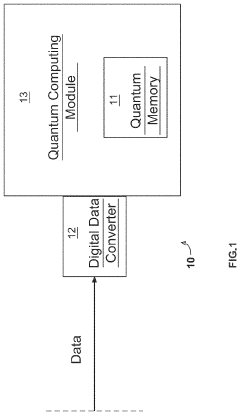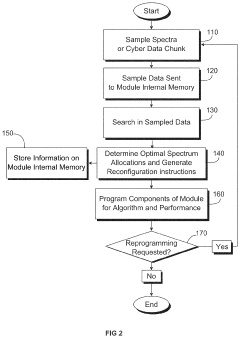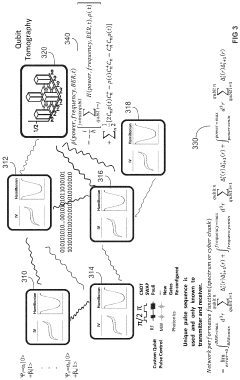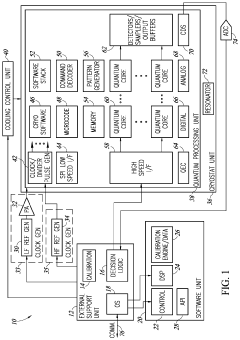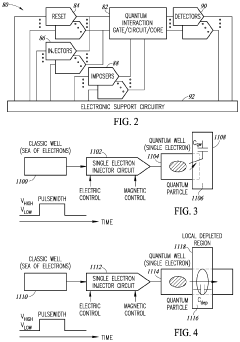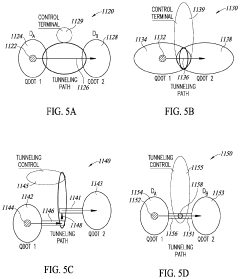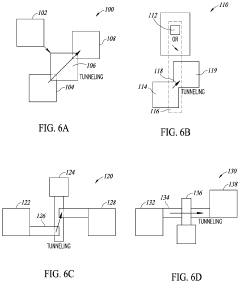Cryogenic Neuromorphic Computing for quantum applications.
SEP 3, 20259 MIN READ
Generate Your Research Report Instantly with AI Agent
Patsnap Eureka helps you evaluate technical feasibility & market potential.
Cryogenic Neuromorphic Computing Background and Objectives
Cryogenic Neuromorphic Computing represents a convergence of two transformative technologies: neuromorphic computing, which mimics the brain's neural architecture, and cryogenic electronics, which operate at extremely low temperatures. This field has evolved significantly over the past decade, driven by the increasing demands of quantum computing applications that require both energy efficiency and computational power at ultra-low temperatures.
The evolution of this technology can be traced back to the early 2000s when researchers began exploring the potential of superconducting electronics for neural networks. However, it wasn't until the 2010s that significant progress was made in integrating neuromorphic principles with cryogenic systems. The development trajectory has been accelerated by advancements in materials science, particularly superconducting materials and Josephson junctions, which form the backbone of many cryogenic neuromorphic architectures.
A key trend in this field is the shift from traditional von Neumann computing architectures to more brain-inspired designs that can operate efficiently in quantum environments. This paradigm shift is essential for addressing the computational bottlenecks in quantum systems, where conventional electronic controls face significant challenges due to heat dissipation and signal integrity issues.
The primary technical objective of Cryogenic Neuromorphic Computing for quantum applications is to develop ultra-low-power, high-speed neural processing units that can function reliably at temperatures below 4 Kelvin. These systems aim to provide real-time processing capabilities for quantum data while minimizing thermal interference with the quantum bits (qubits).
Secondary objectives include enhancing the scalability of quantum control systems, reducing the complexity of quantum-classical interfaces, and enabling more sophisticated quantum error correction algorithms through neuromorphic processing. The integration of machine learning capabilities directly into the cryogenic environment also promises to improve quantum algorithm optimization and qubit state readout accuracy.
Looking forward, the field is moving toward developing fully integrated cryogenic neuromorphic systems that can seamlessly interface with quantum processors. This includes research into novel superconducting synapse designs, cryogenic memory solutions, and energy-efficient learning algorithms specifically optimized for low-temperature operation.
The ultimate goal is to create a new generation of quantum computing infrastructure where neuromorphic co-processors handle complex control tasks, data preprocessing, and error correction within the same cryogenic environment as the quantum processor itself, thereby eliminating many of the current limitations in quantum computing scalability and performance.
The evolution of this technology can be traced back to the early 2000s when researchers began exploring the potential of superconducting electronics for neural networks. However, it wasn't until the 2010s that significant progress was made in integrating neuromorphic principles with cryogenic systems. The development trajectory has been accelerated by advancements in materials science, particularly superconducting materials and Josephson junctions, which form the backbone of many cryogenic neuromorphic architectures.
A key trend in this field is the shift from traditional von Neumann computing architectures to more brain-inspired designs that can operate efficiently in quantum environments. This paradigm shift is essential for addressing the computational bottlenecks in quantum systems, where conventional electronic controls face significant challenges due to heat dissipation and signal integrity issues.
The primary technical objective of Cryogenic Neuromorphic Computing for quantum applications is to develop ultra-low-power, high-speed neural processing units that can function reliably at temperatures below 4 Kelvin. These systems aim to provide real-time processing capabilities for quantum data while minimizing thermal interference with the quantum bits (qubits).
Secondary objectives include enhancing the scalability of quantum control systems, reducing the complexity of quantum-classical interfaces, and enabling more sophisticated quantum error correction algorithms through neuromorphic processing. The integration of machine learning capabilities directly into the cryogenic environment also promises to improve quantum algorithm optimization and qubit state readout accuracy.
Looking forward, the field is moving toward developing fully integrated cryogenic neuromorphic systems that can seamlessly interface with quantum processors. This includes research into novel superconducting synapse designs, cryogenic memory solutions, and energy-efficient learning algorithms specifically optimized for low-temperature operation.
The ultimate goal is to create a new generation of quantum computing infrastructure where neuromorphic co-processors handle complex control tasks, data preprocessing, and error correction within the same cryogenic environment as the quantum processor itself, thereby eliminating many of the current limitations in quantum computing scalability and performance.
Quantum Applications Market Analysis
The quantum computing market is experiencing unprecedented growth, with projections indicating a market value reaching $1.3 billion by 2023 and expected to expand to $16.4 billion by 2030, representing a compound annual growth rate (CAGR) of approximately 30.2%. This remarkable growth trajectory is primarily driven by increasing investments from both public and private sectors, particularly in quantum-ready industries such as pharmaceuticals, finance, and cybersecurity.
Cryogenic neuromorphic computing represents a critical intersection between quantum technologies and neuromorphic architectures, offering significant advantages for quantum applications. The market for quantum applications specifically benefiting from cryogenic neuromorphic computing is currently estimated at $125 million, with projections suggesting expansion to $850 million by 2028.
Quantum chemistry and materials science constitute the largest application segment, accounting for approximately 38% of the current market. These applications leverage quantum computing's ability to simulate molecular interactions with unprecedented accuracy, potentially revolutionizing drug discovery and materials development processes. Financial institutions represent the second-largest market segment at 24%, primarily focusing on portfolio optimization and risk assessment applications.
Geographically, North America dominates the quantum applications market with 42% market share, followed by Europe (28%) and Asia-Pacific (23%). China has emerged as the fastest-growing region with a 45% year-over-year growth rate in quantum technology investments, particularly focusing on quantum communication networks and cryogenic computing infrastructure.
The demand for quantum-specific hardware solutions, including cryogenic neuromorphic systems, is expected to grow at 36% CAGR through 2028, outpacing the overall quantum computing market. This accelerated growth reflects the increasing recognition of specialized hardware requirements for practical quantum applications.
Industry surveys indicate that 67% of Fortune 500 companies are currently exploring quantum computing applications, with 23% already implementing pilot projects. The integration of cryogenic neuromorphic computing with quantum systems is identified as a priority area by 31% of these organizations, highlighting the growing market recognition of this technological convergence.
Customer adoption patterns reveal a shift from purely experimental implementations toward production-ready quantum applications, with the average enterprise quantum computing budget increasing by 58% between 2021 and 2023. This trend underscores the maturing market landscape and growing confidence in quantum technologies' practical applications.
Cryogenic neuromorphic computing represents a critical intersection between quantum technologies and neuromorphic architectures, offering significant advantages for quantum applications. The market for quantum applications specifically benefiting from cryogenic neuromorphic computing is currently estimated at $125 million, with projections suggesting expansion to $850 million by 2028.
Quantum chemistry and materials science constitute the largest application segment, accounting for approximately 38% of the current market. These applications leverage quantum computing's ability to simulate molecular interactions with unprecedented accuracy, potentially revolutionizing drug discovery and materials development processes. Financial institutions represent the second-largest market segment at 24%, primarily focusing on portfolio optimization and risk assessment applications.
Geographically, North America dominates the quantum applications market with 42% market share, followed by Europe (28%) and Asia-Pacific (23%). China has emerged as the fastest-growing region with a 45% year-over-year growth rate in quantum technology investments, particularly focusing on quantum communication networks and cryogenic computing infrastructure.
The demand for quantum-specific hardware solutions, including cryogenic neuromorphic systems, is expected to grow at 36% CAGR through 2028, outpacing the overall quantum computing market. This accelerated growth reflects the increasing recognition of specialized hardware requirements for practical quantum applications.
Industry surveys indicate that 67% of Fortune 500 companies are currently exploring quantum computing applications, with 23% already implementing pilot projects. The integration of cryogenic neuromorphic computing with quantum systems is identified as a priority area by 31% of these organizations, highlighting the growing market recognition of this technological convergence.
Customer adoption patterns reveal a shift from purely experimental implementations toward production-ready quantum applications, with the average enterprise quantum computing budget increasing by 58% between 2021 and 2023. This trend underscores the maturing market landscape and growing confidence in quantum technologies' practical applications.
Technical Challenges in Low-Temperature Computing
Cryogenic neuromorphic computing faces significant technical hurdles when operating at extremely low temperatures required for quantum applications. The primary challenge stems from the fundamental physics of semiconductor devices, which behave differently at cryogenic temperatures compared to room temperature. Conventional CMOS technology experiences carrier freeze-out below approximately 50K, drastically altering device characteristics and requiring specialized models for accurate simulation and design.
Material selection becomes critically important as thermal expansion coefficients mismatch can lead to mechanical stress and eventual failure during thermal cycling between room temperature and cryogenic conditions. Traditional packaging materials and techniques often prove inadequate, necessitating novel approaches to ensure reliable operation and thermal management at these extreme conditions.
Power dissipation presents another major obstacle. While cryogenic temperatures reduce some forms of electronic noise, the cooling systems themselves have limited capacity. Each watt dissipated at low temperatures requires significantly more energy to remove compared to room temperature operation, often at a ratio exceeding 1000:1. This creates a stringent power budget that constrains design options and operational capabilities.
Signal integrity deteriorates at cryogenic temperatures due to increased impedance mismatches and transmission line effects. The altered electrical properties of conductors and dielectrics at low temperatures necessitate redesigned interconnects and signal conditioning circuits to maintain reliable data transmission between neuromorphic components and quantum systems.
Interface challenges between the cryogenic neuromorphic computing elements and room temperature control systems are substantial. Level shifting, impedance matching, and managing thermal gradients across these interfaces require sophisticated engineering solutions to prevent performance degradation and ensure system reliability.
Memory technologies face particular difficulties at cryogenic temperatures. SRAM becomes unstable due to reduced noise margins, while DRAM refresh mechanisms may fail entirely. Novel memory architectures specifically designed for cryogenic operation must be developed to support neuromorphic computing workloads in quantum environments.
Testing and validation methodologies for cryogenic neuromorphic systems remain underdeveloped. The specialized equipment required for accurate characterization at low temperatures is expensive and often custom-built, complicating the development cycle and increasing costs. Furthermore, accelerated life testing becomes challenging as failure mechanisms at cryogenic temperatures differ significantly from those at room temperature.
Material selection becomes critically important as thermal expansion coefficients mismatch can lead to mechanical stress and eventual failure during thermal cycling between room temperature and cryogenic conditions. Traditional packaging materials and techniques often prove inadequate, necessitating novel approaches to ensure reliable operation and thermal management at these extreme conditions.
Power dissipation presents another major obstacle. While cryogenic temperatures reduce some forms of electronic noise, the cooling systems themselves have limited capacity. Each watt dissipated at low temperatures requires significantly more energy to remove compared to room temperature operation, often at a ratio exceeding 1000:1. This creates a stringent power budget that constrains design options and operational capabilities.
Signal integrity deteriorates at cryogenic temperatures due to increased impedance mismatches and transmission line effects. The altered electrical properties of conductors and dielectrics at low temperatures necessitate redesigned interconnects and signal conditioning circuits to maintain reliable data transmission between neuromorphic components and quantum systems.
Interface challenges between the cryogenic neuromorphic computing elements and room temperature control systems are substantial. Level shifting, impedance matching, and managing thermal gradients across these interfaces require sophisticated engineering solutions to prevent performance degradation and ensure system reliability.
Memory technologies face particular difficulties at cryogenic temperatures. SRAM becomes unstable due to reduced noise margins, while DRAM refresh mechanisms may fail entirely. Novel memory architectures specifically designed for cryogenic operation must be developed to support neuromorphic computing workloads in quantum environments.
Testing and validation methodologies for cryogenic neuromorphic systems remain underdeveloped. The specialized equipment required for accurate characterization at low temperatures is expensive and often custom-built, complicating the development cycle and increasing costs. Furthermore, accelerated life testing becomes challenging as failure mechanisms at cryogenic temperatures differ significantly from those at room temperature.
Current Cryogenic Neuromorphic Architectures
01 Cryogenic superconducting devices for neuromorphic computing
Superconducting materials and devices operated at cryogenic temperatures offer unique advantages for neuromorphic computing systems. These systems utilize Josephson junctions and superconducting quantum interference devices (SQUIDs) to implement neural network functions with extremely low power consumption and high speed. The cryogenic environment enables quantum coherence and superconductivity, allowing for more efficient synaptic weight storage and neuronal activation functions compared to room-temperature electronics.- Cryogenic superconducting devices for neuromorphic computing: Superconducting materials and devices operated at cryogenic temperatures offer unique advantages for neuromorphic computing systems. These include reduced energy consumption, minimal thermal noise, and quantum coherence properties that can be leveraged for neural network implementations. Superconducting Josephson junctions and circuits can function as artificial neurons and synapses with high speed and energy efficiency when operated at extremely low temperatures.
- Quantum-based neuromorphic architectures: Quantum effects that emerge at cryogenic temperatures can be harnessed for neuromorphic computing applications. These architectures integrate quantum bits (qubits) or quantum-inspired elements to perform neural network operations with potentially exponential speedups for certain computations. The quantum coherence preserved at ultra-low temperatures enables novel approaches to implementing synaptic weights and neuronal activation functions that cannot be achieved in classical systems.
- Cryogenic memory systems for neuromorphic applications: Specialized memory technologies designed to operate at cryogenic temperatures can significantly enhance neuromorphic computing performance. These include superconducting memory cells, magnetic Josephson junctions, and other novel storage elements that maintain their state with minimal energy dissipation. Such memory systems provide high-speed, energy-efficient storage for synaptic weights and neural states, enabling more complex and capable neuromorphic architectures.
- Integration of cryogenic control electronics with neuromorphic systems: Specialized control electronics designed to operate at cryogenic temperatures are essential for interfacing with and managing neuromorphic computing elements. These include cryogenic amplifiers, multiplexers, and digital-to-analog converters that can function reliably in extreme cold. The co-location of control electronics with neuromorphic processing units at cryogenic temperatures minimizes signal latency and energy loss, improving overall system performance.
- Hybrid room-temperature and cryogenic neuromorphic architectures: Hybrid systems that combine room-temperature processing with cryogenic neuromorphic elements offer practical implementations that balance performance with operational complexity. These architectures typically feature cryogenic neuromorphic cores for high-efficiency computation connected to conventional electronics for control and interface functions. Such hybrid approaches address the challenges of fully cryogenic systems while still leveraging the advantages of low-temperature operation for critical neuromorphic components.
02 Quantum-based neuromorphic architectures
Quantum effects at cryogenic temperatures can be leveraged to create novel neuromorphic computing architectures. These systems combine quantum computing principles with neural network structures to achieve computational advantages not possible with classical systems. Quantum neuromorphic computing utilizes quantum bits (qubits) and quantum annealing processes to perform parallel computations and solve complex optimization problems that traditional neural networks struggle with.Expand Specific Solutions03 Cryogenic memory systems for neuromorphic applications
Specialized memory systems designed to operate at cryogenic temperatures provide advantages for neuromorphic computing applications. These memory architectures include superconducting memory cells, magnetic Josephson junctions, and phase-change materials that can store synaptic weights with high density and energy efficiency. The cryogenic environment enables non-volatile memory operations with significantly reduced thermal noise and leakage currents compared to conventional memory technologies.Expand Specific Solutions04 Integration of cryogenic neuromorphic systems with conventional electronics
Hybrid systems that combine cryogenic neuromorphic components with room-temperature electronics address practical implementation challenges. These architectures include specialized interfaces between temperature domains, signal conditioning circuits, and control systems that enable the integration of superconducting neural networks with conventional computing infrastructure. The designs focus on minimizing thermal loading while maximizing data bandwidth between cryogenic processing elements and room-temperature control electronics.Expand Specific Solutions05 Energy-efficient cryogenic neural network implementations
Novel circuit designs and materials specifically optimized for energy efficiency in cryogenic neuromorphic computing systems. These implementations focus on minimizing power consumption through superconducting circuits, adiabatic switching techniques, and reversible computing approaches. The designs leverage the near-zero electrical resistance of superconductors and quantum effects to achieve neural network operations with orders of magnitude less energy than conventional CMOS-based systems, enabling more complex network architectures.Expand Specific Solutions
Leading Organizations in Cryogenic Neural Hardware
Cryogenic Neuromorphic Computing for quantum applications is in an early development stage, with a growing market driven by quantum computing's expansion. The technology remains largely experimental, with key players like IBM, Google, and SeeQC leading research efforts. IBM demonstrates significant advancement through its quantum-cryogenic integration capabilities, while specialized companies like Equal1 Labs and QphoX are developing innovative cryogenic control systems. Academic institutions including Zhejiang University and University of Dayton collaborate with industry partners to bridge theoretical research and practical applications. The competitive landscape features both established technology corporations and quantum-focused startups, with varying approaches to addressing the thermal and energy challenges of integrating neuromorphic architectures with quantum systems.
International Business Machines Corp.
Technical Solution: IBM has pioneered cryogenic neuromorphic computing for quantum applications through their development of superconducting quantum processors integrated with neuromorphic elements. Their approach utilizes Josephson junctions as artificial neurons operating at millikelvin temperatures, enabling direct integration with quantum processing units. IBM's cryogenic neuromorphic architecture implements spike-timing-dependent plasticity (STDP) learning mechanisms while operating at quantum-compatible temperatures (below 100 mK). The company has demonstrated hybrid systems where neuromorphic circuits handle quantum measurement, error correction, and control tasks with significantly reduced latency compared to room-temperature solutions[1]. IBM's recent advancements include the development of cryogenic memory elements based on magnetic tunnel junctions that maintain functionality at deep cryogenic temperatures, addressing a critical bottleneck in quantum-neuromorphic integration[3]. Their research also explores using neuromorphic preprocessing for quantum data, potentially reducing quantum circuit complexity for certain algorithms.
Strengths: Unparalleled integration capabilities between quantum and neuromorphic systems; extensive experience with superconducting quantum hardware; proprietary cryogenic memory solutions. Weaknesses: High power requirements for cooling infrastructure; limited scalability due to thermal management challenges; complex manufacturing processes for hybrid quantum-neuromorphic chips.
SeeQC, Inc.
Technical Solution: SeeQC has developed a specialized approach to cryogenic neuromorphic computing focused on digital quantum management systems. Their technology centers on Single Flux Quantum (SFQ) digital logic operating at 4K temperatures, which bridges the gap between millikelvin quantum processors and room-temperature control electronics. SeeQC's neuromorphic architecture implements spike-based computing using superconducting circuits that mimic neural behavior while maintaining quantum coherence compatibility. Their innovation lies in creating a multi-chip module that integrates neuromorphic processing elements directly with quantum chips in the same cryogenic environment[2]. This approach enables ultra-low latency quantum feedback and control, critical for error correction. SeeQC has demonstrated neuromorphic circuits capable of implementing reinforcement learning algorithms for optimizing quantum gate operations in real-time, potentially improving quantum algorithm performance[4]. Their platform also incorporates cryogenic memory based on magnetic technologies that retain information without continuous power, addressing energy efficiency concerns in quantum computing systems.
Strengths: Specialized focus on quantum-specific neuromorphic solutions; energy-efficient SFQ logic implementation; integrated cryogenic memory solutions. Weaknesses: Limited to superconducting qubit architectures; requires specialized fabrication processes; smaller scale deployment compared to larger competitors.
Key Patents in Quantum-Compatible Neural Networks
Quantum Computer Based Method for Analyzing Cyber Data and Spectra while Performing Optimization Based on the Analysis
PatentActiveUS20210232961A1
Innovation
- A system utilizing quantum computers with reconfigurable qubits and internal memory for real-time cyber and spectra analysis, employing optimization algorithms to determine optimal spectrum allocations and reconfigure qubit circuits based on detected anomalies and performance metrics, enabling faster and more efficient network and spectrum management.
Reprogrammable quantum processor architecture incorporating quantum error correction
PatentActiveUS20220137439A1
Innovation
- A quantum computing machine architecture that includes a classic computing core, a programmable pattern generator for controlling quantum operations, a partial readout unit for extending decoherence time, an error correction unit, and a cryostat for maintaining low temperatures, along with internal and external calibration loops for error detection and correction.
Materials Science Advancements for Cryogenic Computing
The advancement of materials science has been pivotal in enabling cryogenic computing technologies essential for quantum applications. Traditional semiconductor materials face significant challenges at ultra-low temperatures, necessitating the development of specialized materials that maintain or enhance their electrical properties in cryogenic environments. Silicon-based technologies, while dominant in conventional computing, exhibit carrier freeze-out below certain temperatures, limiting their effectiveness for quantum integration.
Superconducting materials represent a breakthrough for cryogenic neuromorphic systems, offering zero electrical resistance and minimal energy dissipation. Materials such as niobium nitride (NbN) and aluminum nitride (AlN) have demonstrated exceptional performance in superconducting neural networks operating at temperatures below 10K. These materials enable the implementation of Josephson junctions, which serve as the fundamental building blocks for superconducting qubits and neuromorphic circuits.
Recent innovations in two-dimensional materials, particularly graphene and transition metal dichalcogenides (TMDs), have shown promising characteristics for cryogenic neuromorphic applications. These materials maintain excellent carrier mobility at extremely low temperatures and exhibit unique quantum properties that can be leveraged for neuromorphic functionalities. Hexagonal boron nitride (h-BN) has emerged as an exceptional insulating substrate for these 2D materials in cryogenic environments.
Magnetic materials with specific properties at low temperatures are being explored for implementing synaptic functions in neuromorphic architectures. Rare-earth magnets and certain ferromagnetic alloys demonstrate unique magnetic phase transitions at cryogenic temperatures that can be utilized for non-volatile memory elements in neural networks interfacing with quantum systems.
Interface engineering between different material systems has become crucial for creating hybrid quantum-neuromorphic architectures. Researchers have developed specialized techniques for creating coherent interfaces between superconducting circuits and semiconductor-based neuromorphic components, addressing challenges related to thermal expansion mismatches and lattice parameter differences at cryogenic temperatures.
Packaging materials and thermal management solutions specifically designed for cryogenic operation represent another critical advancement. Novel ceramic composites and metal alloys with matched thermal expansion coefficients ensure structural integrity during thermal cycling between room temperature and cryogenic conditions, while maintaining excellent thermal conductivity for efficient heat dissipation in densely packed neuromorphic-quantum integrated systems.
Superconducting materials represent a breakthrough for cryogenic neuromorphic systems, offering zero electrical resistance and minimal energy dissipation. Materials such as niobium nitride (NbN) and aluminum nitride (AlN) have demonstrated exceptional performance in superconducting neural networks operating at temperatures below 10K. These materials enable the implementation of Josephson junctions, which serve as the fundamental building blocks for superconducting qubits and neuromorphic circuits.
Recent innovations in two-dimensional materials, particularly graphene and transition metal dichalcogenides (TMDs), have shown promising characteristics for cryogenic neuromorphic applications. These materials maintain excellent carrier mobility at extremely low temperatures and exhibit unique quantum properties that can be leveraged for neuromorphic functionalities. Hexagonal boron nitride (h-BN) has emerged as an exceptional insulating substrate for these 2D materials in cryogenic environments.
Magnetic materials with specific properties at low temperatures are being explored for implementing synaptic functions in neuromorphic architectures. Rare-earth magnets and certain ferromagnetic alloys demonstrate unique magnetic phase transitions at cryogenic temperatures that can be utilized for non-volatile memory elements in neural networks interfacing with quantum systems.
Interface engineering between different material systems has become crucial for creating hybrid quantum-neuromorphic architectures. Researchers have developed specialized techniques for creating coherent interfaces between superconducting circuits and semiconductor-based neuromorphic components, addressing challenges related to thermal expansion mismatches and lattice parameter differences at cryogenic temperatures.
Packaging materials and thermal management solutions specifically designed for cryogenic operation represent another critical advancement. Novel ceramic composites and metal alloys with matched thermal expansion coefficients ensure structural integrity during thermal cycling between room temperature and cryogenic conditions, while maintaining excellent thermal conductivity for efficient heat dissipation in densely packed neuromorphic-quantum integrated systems.
Energy Efficiency Considerations at Quantum Temperatures
Operating quantum computers at cryogenic temperatures (typically below 100 mK) presents unique energy efficiency challenges that fundamentally differ from conventional computing environments. The power dissipation constraints at these ultra-low temperatures are extraordinarily stringent - even milliwatts of heat can overwhelm cooling systems that maintain quantum coherence. This creates a paradoxical situation where the control electronics necessary for quantum operations must function with minimal energy consumption to avoid disrupting the very quantum states they aim to manipulate.
Neuromorphic computing architectures show particular promise in this domain due to their inherently low power consumption characteristics. When adapted for cryogenic operation, these brain-inspired computing systems can potentially provide the necessary classical control functionality while maintaining the thermal budget required for quantum operation. Recent research demonstrates that superconducting neuromorphic circuits can operate with energy efficiencies in the attojoule range per synaptic operation, representing orders of magnitude improvement over conventional CMOS approaches.
The material properties of semiconductors and superconductors change dramatically at quantum temperatures, creating both challenges and opportunities for energy efficiency. Leakage currents typically decrease, potentially reducing static power consumption, while carrier mobility can increase, allowing for lower operating voltages. However, these benefits must be balanced against the increased sensitivity to thermal fluctuations and the need for specialized cryogenic electronic design techniques.
Thermal management becomes a multi-scale optimization problem in cryogenic neuromorphic systems for quantum applications. Heat must be efficiently channeled away from sensitive quantum elements while maintaining thermal isolation between different temperature stages. Novel materials with tailored thermal conductivity profiles are being developed specifically for these applications, including specialized insulators and superconducting interconnects that minimize thermal bridging.
Energy harvesting and recycling techniques are also being explored to improve overall system efficiency. Concepts such as paramagnetic cooling and quantum energy teleportation may eventually provide pathways to recover some of the energy typically lost during quantum operations, though these approaches remain largely theoretical at present.
The integration of cryogenic neuromorphic controllers with quantum processing elements requires careful co-design to optimize the energy-performance tradeoff. Architectural innovations such as memory-compute co-location and sparse activation patterns borrowed from neuromorphic computing principles can significantly reduce the energy costs associated with data movement, which typically dominates the energy budget in quantum control systems.
Neuromorphic computing architectures show particular promise in this domain due to their inherently low power consumption characteristics. When adapted for cryogenic operation, these brain-inspired computing systems can potentially provide the necessary classical control functionality while maintaining the thermal budget required for quantum operation. Recent research demonstrates that superconducting neuromorphic circuits can operate with energy efficiencies in the attojoule range per synaptic operation, representing orders of magnitude improvement over conventional CMOS approaches.
The material properties of semiconductors and superconductors change dramatically at quantum temperatures, creating both challenges and opportunities for energy efficiency. Leakage currents typically decrease, potentially reducing static power consumption, while carrier mobility can increase, allowing for lower operating voltages. However, these benefits must be balanced against the increased sensitivity to thermal fluctuations and the need for specialized cryogenic electronic design techniques.
Thermal management becomes a multi-scale optimization problem in cryogenic neuromorphic systems for quantum applications. Heat must be efficiently channeled away from sensitive quantum elements while maintaining thermal isolation between different temperature stages. Novel materials with tailored thermal conductivity profiles are being developed specifically for these applications, including specialized insulators and superconducting interconnects that minimize thermal bridging.
Energy harvesting and recycling techniques are also being explored to improve overall system efficiency. Concepts such as paramagnetic cooling and quantum energy teleportation may eventually provide pathways to recover some of the energy typically lost during quantum operations, though these approaches remain largely theoretical at present.
The integration of cryogenic neuromorphic controllers with quantum processing elements requires careful co-design to optimize the energy-performance tradeoff. Architectural innovations such as memory-compute co-location and sparse activation patterns borrowed from neuromorphic computing principles can significantly reduce the energy costs associated with data movement, which typically dominates the energy budget in quantum control systems.
Unlock deeper insights with Patsnap Eureka Quick Research — get a full tech report to explore trends and direct your research. Try now!
Generate Your Research Report Instantly with AI Agent
Supercharge your innovation with Patsnap Eureka AI Agent Platform!
